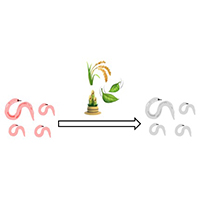Evaluation of nematocidal effects of some medicinal plant extracts against root-knot nematodes (Meloidogyne incognita)

Accepted: 1 January 2020
HTML: 513
All claims expressed in this article are solely those of the authors and do not necessarily represent those of their affiliated organizations, or those of the publisher, the editors and the reviewers. Any product that may be evaluated in this article or claim that may be made by its manufacturer is not guaranteed or endorsed by the publisher.
Hundreds of highly toxic chemical pesticides and their conventional unsafe formulations of varying toxicities are used extensively to control pests, diseases, and weeds to increase agricultural production. The use of bio or botanical pesticides, which have been found effective, safe, and eco-friendly, could possibly provide a viable solution. Thus, the development and production of environment-friendly botanical pesticides and their water-based formulations, to replace the highly toxic agro-chemicals and unsafe formulations, has gained significant importance towards developing appropriate strategies for crop protection. The present study was aimed to evaluate the nematocidal nature of the aqueous extracts of Allium sativum, Urtica dioica, Sophora mollis, Ephedra intermedia, and Tanacetum baltistanicum. For this purpose, the plant material was dried in shade and mechanically ground into a powder form. The methanolic extracts of each plant sample were obtained and further extracted into different organic and aqueous fractions. The polar organic and aqueous fractions were further subjected to in vitro studies against Meloidogyne incognita, a common root-knot nematode. The results revealed that the polar organic and aqueous extracts of all the tested plants showed excellent results with total mortality of 75-95% at the concentrations of 0.125-1% after 72 h of the treatment. These results can be exploited further for their efficacy against M. incognita through on-field applications. The nematocidal effect of tested extracts indicates that some polar oxygenated secondary metabolites with lipophilic properties may be responsible to damage the cytoplasmic membrane of the nematode cells by interfering with the enzyme protein structure through their functional groups.
How to Cite
PAGEPress has chosen to apply the Creative Commons Attribution NonCommercial 4.0 International License (CC BY-NC 4.0) to all manuscripts to be published.

 https://doi.org/10.4081/ija.2020.1475
https://doi.org/10.4081/ija.2020.1475



